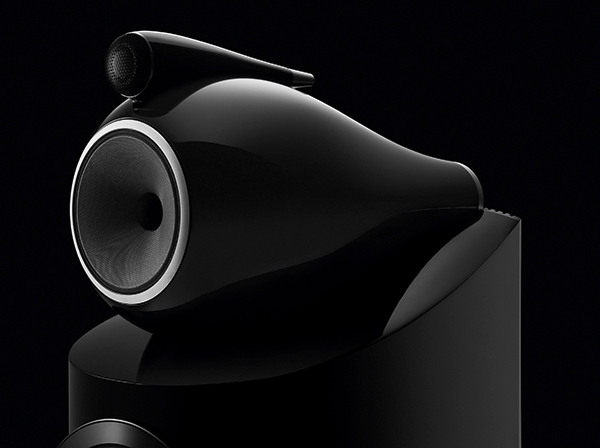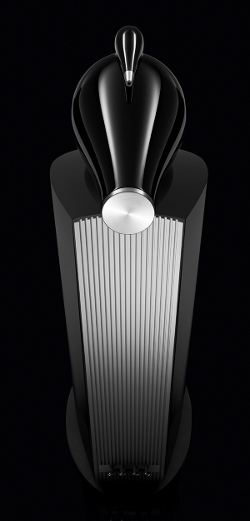Remaking a Classic: The B&W 800 D3 Speaker Page 2

The main ones are obviously related to the drive units. I’ve already mentioned it above but it’s worth restating that the most important breakthrough in terms of drive unit technology is the introduction of the Continuum cone. Kevlar was our signature technology for many years (since the 70s) so we really wanted to be 100 percent sure that its successor was better in all possible aspects of acoustic performance. The Continuum cone is still based on the concept of controlling cone break-up modes which are inevitably present in-band if you want to cover a large frequency range, as is the case here. This new design uses a combination of mechanical damping and the right cone stiffness and topology to both control the assembly break-up and prevent it from radiating unwanted sound, resulting in a smoother acoustic response, lower non-linear distortion, and a more controlled directivity pattern.
The introduction of the Continuum cone has had a dramatic impact on midrange clarity and neutrality. In fact, during our research work, these improvements forced us to reconsider all our other design choices (bass units, tweeters, cabinets), as their limitations were suddenly made audible by the sheer transparency of Continuum.
The new 800 Series Diamond also introduces a new bass cone technology, the Aerofoil cone. This new cone design, combined with improved motors and suspensions, leads to tighter and less colored bass.
The new 800 Series Diamond also introduces a new bass cone technology, the Aerofoil cone. In the case of bass cones, the Bowers & Wilkins approach is different (from the midrange cone approach) and we try to achieve a pistonic behavior, as break-up modes can be pushed outside of the frequency band of that unit. In simple terms this means creating a very stiff cone while maintaining a low mass, needed for high sensitivity. In the case of the Aerofoil cone, we achieve this by using a sandwich construction, for high bending stiffness, which uses carbon skins on both sides of a syntactic foam core. The idea behind the Aerofoil concept is to create a variable thickness cone, allowing us to push the assembly break-up to a higher frequency. This new cone design, combined with improved motors and suspensions, leads to tighter and less colored bass, thanks to the reduction of non-linear distortion and near-pistonic cone behavior. This is particularly true of the largest model, the 800 D3: this uses two incredibly linear 10 inch units. In that model we also use a sandwich construction for the dust cap itself in order to further improve the cone’s pistonic behavior.Finally the diamond tweeter design was also reconsidered. Our research clearly indicated that diamond was still the best choice for the tweeter dome. However we didn’t want to stop there so the rest of the assembly was reassessed, with a more linear motor and optimized suspension, leading to lower non-linear distortion and cleaner treble.
As previously mentioned, our aim is to make sure that the loudspeaker doesn’t add anything to the original musical signal. Reducing non-linear distortion is the engineering way to achieve this goal.
The other components also have to be mentioned as their behavior is critical. In the case of enclosures and cabinets, our aim is simply to make them as inert as possible in order to prevent them from radiating uncontrolled energy which would color the sound and affect the imaging. To that purpose, the bass cabinets, plinths, chassis, midrange Turbine heads, and tweeter enclosures were designed using computer simulation (based on the finite element method) to minimize vibration levels.
 The midrange Turbine head was particularly challenging. Our previous design (known as the Marlan head) was very good in terms of acoustic behavior, as its outer and internal shapes allowed us to control internal standing wave and control dispersion. We however knew that its vibrational behavior could be improved. We therefore spent a lot of time working with a combination of computer simulations and rapid prototyping to optimize the new head, both in terms of material and shape. The new design, called the Turbine head for obvious reasons (its shape!) combines great acoustic behavior through its shape, and great mechanical behavior through the use of aluminum, a complex internal ribbing structure and internal tuned mass dampers.
The midrange Turbine head was particularly challenging. Our previous design (known as the Marlan head) was very good in terms of acoustic behavior, as its outer and internal shapes allowed us to control internal standing wave and control dispersion. We however knew that its vibrational behavior could be improved. We therefore spent a lot of time working with a combination of computer simulations and rapid prototyping to optimize the new head, both in terms of material and shape. The new design, called the Turbine head for obvious reasons (its shape!) combines great acoustic behavior through its shape, and great mechanical behavior through the use of aluminum, a complex internal ribbing structure and internal tuned mass dampers.
The cabinet construction also benefits from internal and external optimization. The curved reversed wrap on “headed product” limits diffraction while the internal Matrix structure increases the assembly’s stiffness for lower sound radiation. The Matrix uses a hybrid metal-wood construction on headed products, using birch plywood, steel, and aluminum in order to increase stiffness where it is needed.
The midrange chassis and the solid-body tweeter both benefited from the simulation work, helping us to create more inert parts, further reducing the coloration in the midrange and treble.
S&V: What’s different since the last 800 series upgrade in the way of engineering instrumentation, material costs, or other factors that facilitated the advances in this new line?
Rousseau: The main breakthrough in terms of design tools is the extensive use of computer simulation (finite element analysis). Bowers & Wilkins has been using these tools for many years but this is the first time they have been used on almost every component in the system. The obvious advantage is it allows us to assess and validate designs prior to prototyping, which obviously saves time. In other words, the team can be a lot more creative during the project without impacting timing. As we also have extensive mechanical and acoustic measurement capabilities, this simulation work can be fully validated. Laser vibrometry in particular is an essential tool in that process.
In terms of material cost, some of the new components are more costly than the old units, such as the Turbine head assembly. This has meant we’ve also spent a lot of time on refining our manufacturing processes and assemblies in order to at least partially offset this cost by being smarter and more controlled.
S&V: The tapered tweeter pod housing has become a hallmark of the 800 series products for several generations now, and has now been extended to the midrange driver as well. Along with its aesthetic appeal, what sonic benefits derive from it?
Rousseau: The new Turbine head was designed to exhibit optimized mechanical and acoustical behavior. The chosen shape achieves both objectives by being narrower at the front. Its smaller frontal area means it is stiffer and radiates less sound. The internal shape is critical as well as it helps minimize standing waves. The internal midrange volume had to be maintained for performance reasons; this naturally led us to increase the section at the rear, leading to the shape you see.
S&V: The 800 D3 is the best Bowers & Wilkins can do to create a perfect-as-possible speaker—the “pinnacle of audio perfection.” Is there still room for improvement? What would be the focus of research going forward from here? How do you make it even better?
Rousseau: The 800 D3 is the best loudspeaker we can create at this point in time. However, as we realized during all this work, the more you assess and reevaluate what you’ve got (through listening, measurements, and simulations) the more likely you are to find other imperfections worth fixing. If one combines this with never-ending progress in measurement techniques, and simulation tools, I’m pretty sure that we will be able to come up with something better in the future. It might take us quite a few years though…





























































